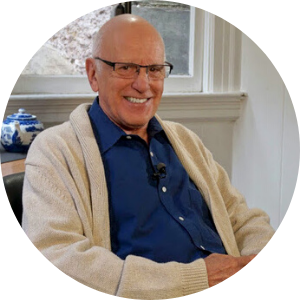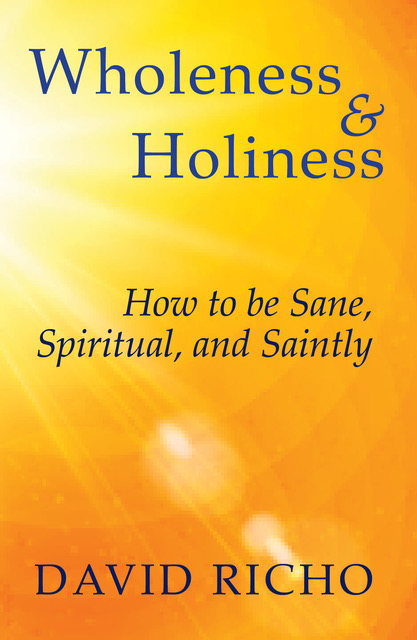Psychotherapist David Richo explains the interlude between wholeness and holiness.
by David Richo
“An inner wholeness keeps pressing its still unfulfilled claims upon us.“
– Emma Jung, The Grail Legend
Our lifetime on this earth gives us three magnificent chances to evolve into the fullness of our humanity:
We can become wholly who we are.
We can be wholesome in how we act.
We can be holy in how we live.
The first takes psychological work on ourselves. The second calls for spiritual awareness and practices. The third is a grace that leads us to dedicated action.
From a psychological perspective sanity is what we need so that we can survive and thrive in the world. The development of our body-mind is fulfilled when we are psychologically sound. Sanity is not simply the opposite of madness. It is full mental health and exuberant well-being.
From a wholeness perspective, we feel a longing in ourselves for something more than individual surviving and thriving. We are oriented toward an ever-expanding spiritual consciousness. The evolution of our body-mind is fulfilled when we are spiritually motivated.
From a faith perspective, we believe that sanctity is our divinely imprinted calling and destiny. The divine purpose of our body-mind is fulfilled when we are saintly in our choices.
These three intertwine and beam out to the world as three rays of one sun, fully actualized personhood.
Sanity, spirituality, and sanctity keep evolving in meaning. The definition of an elbow has remained the same throughout the centuries. This is because it is what it is no matter what is happening socially or politically. But the definitions of sanity, spirituality, and sanctity change over time since they are directly influenced by what is happening in the world. All three, unlike an elbow, are interactive, directly influenced by contemporary issues and necessarily responsive to society’s needs. In this twenty-first century our world is more tightly interconnected than it ever has been. Environmental concerns, societal issues, and the political scene are crucial to how we design and maintain our mental health, our spirituality, and the shape of our saintly calling.
We see psychological sanity as a foundation and spirituality as a bridge. They are not the whole story of wholeness. We can come to see sanctity as our ultimate goal. Sanity is a beginning. Spirituality is a conduit. Neither one nor both constitute the completion of a life of wholeness. Neither can go far enough. Sanctity is our full aliveness, personal fulfillment, the divine completion of a human life, the presence of holiness on earth. Our challenge is to integrate not two but three resplendent trails to humanness.
We keep in mind that all three options remain choices that are being offered to us. Some people choose to go no farther than psychological health. Some people deny there is a spiritual or saintly dimension at all. Some people focus on spiritual practices and neglect mental health concerns. Some focus on both. We can do what psychology recommends and become truly healthy. We can engage in spiritual practices and grow spiritually. But we can also combine union with the divine, heroic giving, dedicated focus, and full openness to grace, and thereby journey toward sanctity.
Sanctity is not limited to famous people like Joan of Arc or Archbishop Oscar Romero. The single mother who cares so single-mindedly for her children is certainly a saintly heroine. Saintly heroism refers to selfless love, dedicated service, bold courage, hearted-centered focus, willingness to risk one’s safety and security. It includes a turning from ego-centeredness to social consciousness, universal love, unlimited caring. We do not have to be daunted by the bigness of this enterprise. We can firmly trust that we do not hear a call without being given graces sufficient for fulfilling it. This is how sanctity is a synchronous blend of abundant love that we keep showing and boundless grace that we keep receiving. Grace is the gift dimension of life, available in all three stages of our growth.
Both spirituality and holiness flourish optimally in an atmosphere of psychological health. Likewise, wholeness happens best in the context of a life of goodness with a commitment to co-create a world of justice, peace, and love—our spiritual goals. Holiness happens in those special times when we soar beyond psychological health and spiritual wholesomeness. We are given the grace to go over-the-top in our virtue, over and above what is required, above and beyond what is expected, past spiritual practices, beyond the call of duty. We embrace the unrequired extra that makes us saints: We love in daring ways; we access wisdom beyond ordinary knowledge; we usher healing, even miracles, into our world. From the Christian perspective, such a world is the kingdom of God, the completion of all things in Christ.
Every human person, with or without religion, can walk through this sacred door since sanctity can happen in myriad ways. We can be big saints or little saints: We can say yes to moments of saintliness, internally or externally, and that may be enough. We can say yes to a lifetime of sanctity and that will be more than enough. Each person is called to sanctity but the spectrum is wide, as wide as human nature itself. One saintly act is all it takes for success.
None of the three goals is expected to be fulfilled all the time. No one is sane, spiritual, and saintly every minute of the day. Our daily expectations of ourselves are appropriate when they are “good enough”:
We are sane almost all the time.
We are spiritual most of the time.
We are saintly from time to time.
Let’s consider the origin of some of the words we are using. ‘Sanity’ is from the Latin sanus which means health, soundness of body and mind. ‘Spirituality’ is from the Latin for ‘breath’ since an empowering Spirit breathes through us, lives in us, acts through us. ‘Sanctity’ is from the Latin sanctus, holy or sacred. In the Christian view, saints manifest the sacred indwelling presence of the Holy Spirit, the divine energy of wisdom and love, the experience of the sacred. ‘Wholeness’ and ‘holiness’ derive from German and Dutch words with similar meanings: unimpaired, thorough, full, integral.
All three levels of our development—sanity, spirituality, and sanctity—work in concert. No one of them interferes with any other.
Let’s use the example of healthy assertiveness to see how the three goals interflow: Our psychological work shows us how to ask for what we want, express our needs, protect our boundaries. When we bring a spiritual consciousness to those goals we also ask for societal justice, speak up about injustice, take a stand to protect others as equal in value to ourselves. In saintliness, we put ourselves on the line as we do this. We extend our caring compassion without stint or limit. We put ourselves second if to do so will be vital to someone else’s survival. We speak truth to power even when it may get us into big trouble.
Sanity, spirituality, and sanctity all include both consciousness and practice, awareness and action:
When we are psychologically healthy we are aware of ourselves, our feelings, our talents, our limitations. We then make wise choices that help us fulfill our personal goals and contribute to the world around us. It is up to us to tend this process. When we do, we feel wholesome, body, heart, and mind. Sanity is goal-oriented. A goal is a purpose we strive to fulfill so our lives can be satisfactory.
When we are spiritually vibrant we are aware of the transcendent radiance in the universe and engage in actions that promote its conscious evolution. Spirituality is dedicated to a unique destiny, something more than a goal. It is the fulfillment of our life purpose. The word “destiny” does not mean predetermined or fated. It refers to the unfolding of our full capacity for humanness.
When we are saintly we are aware of the presence of God in all things and in every moment. We then take every opportunity to act in accord with the divine resolve to co-create an evolved world. We are thoroughly convinced that everything is holy. This leads us to use the word “God” in a non-dual way. God is the wholeness-holiness in us and in all things.
One does not have to be a traditional believer or member of a church to be a saint. We might, for instance, still be on board for sanctity when we say this: “I don’t know if there is a God but I want to act as if there were a God and as if this God were love.”
Each of the three goals of a fully human life—sanity, spirituality, and sanctity—places a uniquely thrilling spin on our sense of ourselves:
Our sense of ourselves when we are sound in body and mind is unreserved self-esteem. We are self-confident and secure. We can step up to the plate when curve balls are pitched our way. We maintain equanimity in the midst of chaos. We still appreciate and seek validation from others but now we self-validate more often.
Our sense of ourselves when we are spiritually oriented is expanded consciousness. Pierre Teilhard de Chardin, in The Human Phenomenon, describes it best: “We have ever more perfect eyes in a world in which there is always more to see.” Our sense of self spiritually is also responsiveness to our unique calling to make the world more just and peaceful than it is now, to make ourselves more loving than we have been yet.
Our sense of ourselves as saints is total gratitude for the graces we receive and total willingness to embrace the heroic challenges the world keeps tossing in our direction. This includes a sense of ordination to a holy calling: “You are a chosen people, a royal priesthood, a holy nation, God’s special possession, that you may declare the praises of him who called you out of darkness into his wonderful light.” 1Peter 2:9
Thus, our progress in any of the three S’s does not rely only on our actions. Something in us is contributing to making full humanness happen. Carl Jung, in “Concerning Mandala Symbolism,” states it clearly: “There is in the psyche a process that seeks its own goal no matter what the external factors may be…the almost irresistible compulsion and urge to become what one is.”
Aristotle used the word “entelechy” to refer to this inner life force in every being to grow up into what it really is. An instinctive energy within us directs the growth of our body-minds to actualize the full breadth of our identity. We aren’t becoming herons; we are becoming full-on humans. We are becoming by natural predisposition what we have the capacity to be. Our human entelechy is an ineradicable, irrepressible arc in the direction of all the rainbow colors of self-emergence: sanity, spirituality, and sanctity.
This stunning power is the foundation of our trust in our bodies, minds, emotions, spirit. Something alive inside is infallibly oriented to full self-emergence. We align ourselves with the entelechy of sanity when we make healthy choices. We align spiritually when we go beyond our apparent limits into the transcendent. We align in holiness when we live in accord with the voice and movements of the indwelling Spirit.
When we see someone in trouble and have only psychology to help us make sense of it we might say: “That’s happening over there and I am over here.” This may be safety-making but it is separation-making too. This is a minimum opening of our entelechy. In spiritual awareness and commitment we ask what the good Samaritan might ask: “How am I part of this suffering and how can I be a force of healing?” In saintliness we see someone suffering and we do not say: “There but for the grace of God go I.” We say: “There by the grace of God go I.” Our compassion flows from irresistible communion—the ultimate and full expression of our human entelechy as a deep kinship. Father Greg Boyle, SJ: Tattoos on the Heart: The Power of Boundless Compassion wrote about kinship as “not serving the other, but being one with the other…. Jesus was not ‘a man for others’; he was one with them. There is a world of difference in that.”
In any here and now we can check in with ourselves about our three spectacular human enterprises. As a daily practice we can also ask ourselves three questions. The first is about sanity, the second about spirituality, the third about sanctity:
What opportunity do I have today to be healthy, both physically and psychologically? What opportunity do I have to be healthy, both physically and psychologically, in this very moment?
What spiritual destiny can I give myself to today? What is the door, the on-ramp I see before me in this moment?
What graces of wisdom and daring action can I take advantage of today? What love in my heart is opening now so I can be a channel of grace?
We ask for this reliable grace on our marvel-filled pilgrimage to no less than three shrines, sanity, spirituality, and sanctity. They will appear together as the one destination of the Camino of this lifetime. Indeed, they show us why we have been given a lifetime.
Find out more

David Richo, Ph.D. is psychotherapist, writer, and workshop leader. He teaches at a variety of organisations including Esalen and Spirit Rock Buddhist Center. He shares his time between Santa Barbara and San Francisco, California. Dave combines psychological and spiritual perspectives in his work.

Bookshelf
Wholeness and Holiness: How to be Sane, Spiritual, and Saintly by David Richo, published by Orbis, paperback


